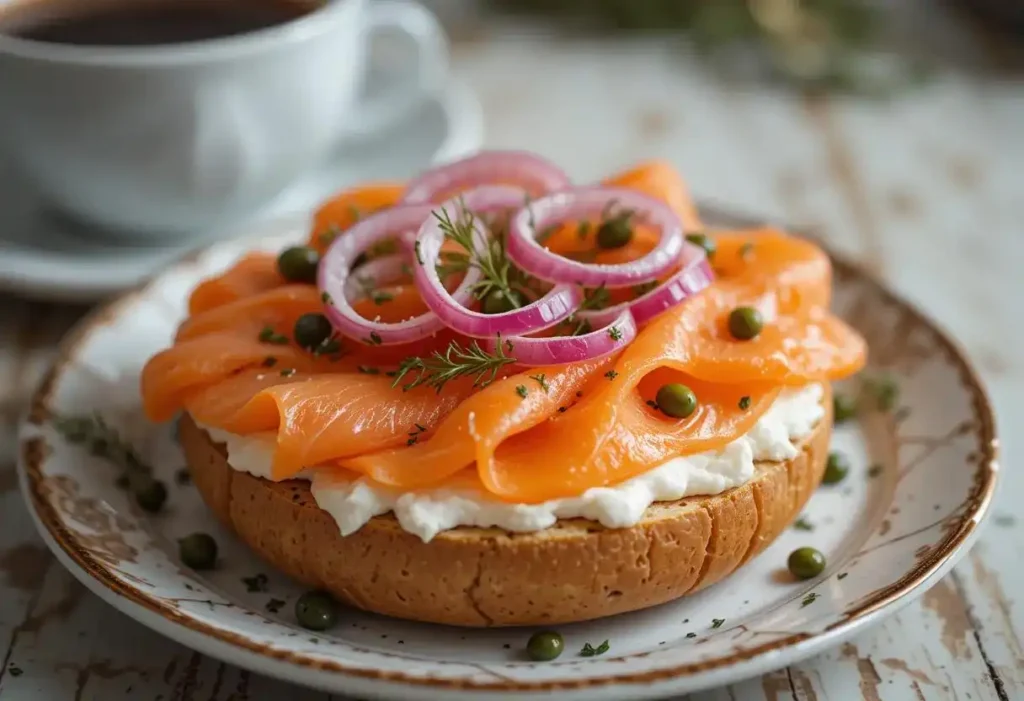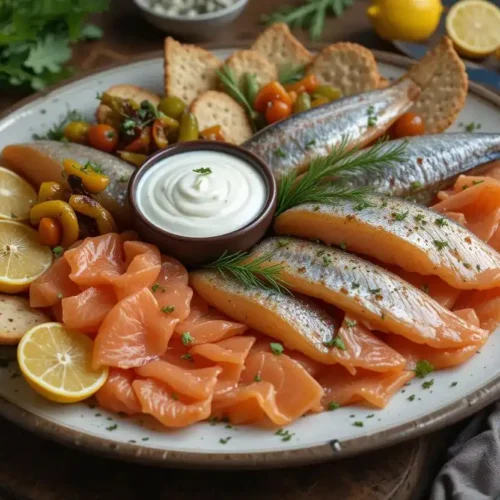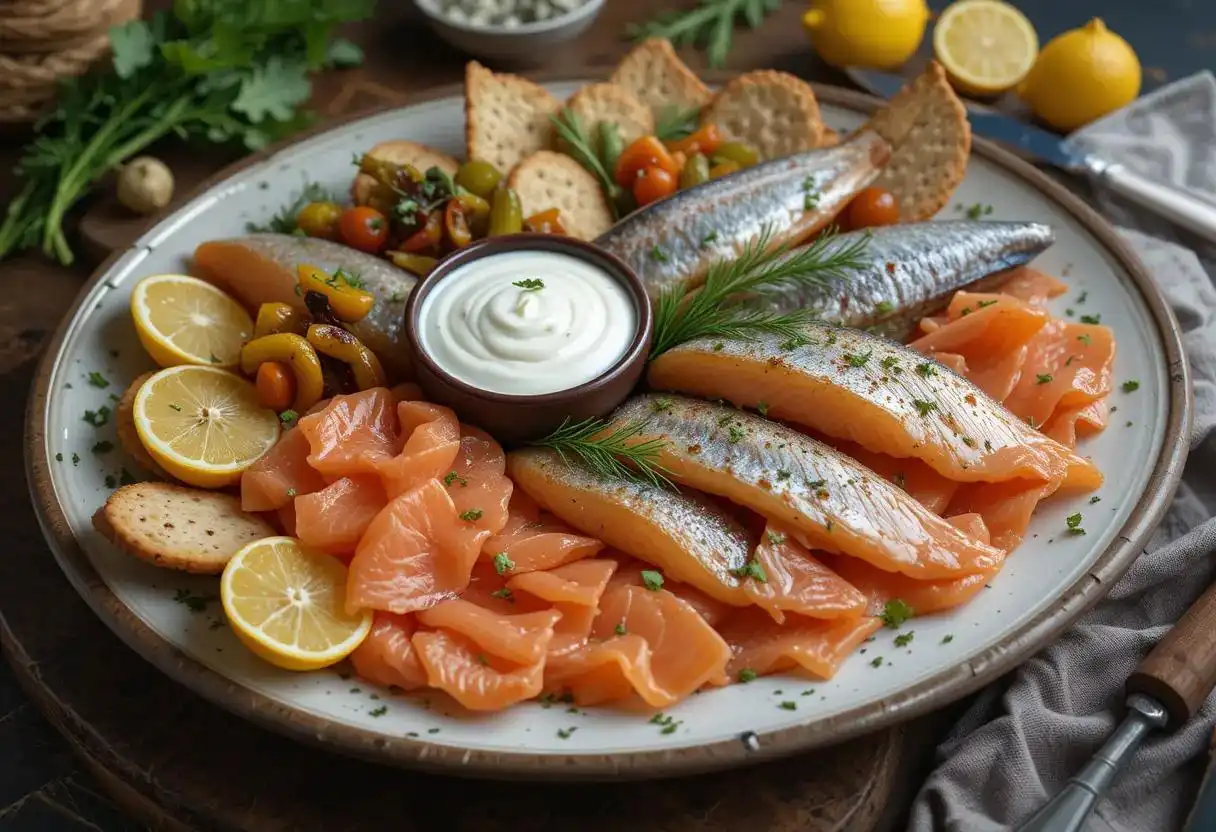Growing up in a home where food was both ritual and art, smoked fish was more than just a dish it was a celebration. My grandmother, Nonna Lucia, used to say, “The smoke carries the soul of the fish.” She wasn’t wrong. I still remember her using alderwood chips and a handmade smoker in the backyard. She didn’t speak much while smoking fish, but her eyes sparkled with every swirl of smoke, knowing it was our Sunday table’s star.
Though I was raised in an Italian household, smoked fish brought in the flavors of the cold Nordic shores and the heart of Eastern Europe. From Scandinavian lox to Russian smoked mackerel, it’s a dish that unites continents.
Today, I’ll walk you through a traditional, yet customizable, method to smoke your own salmon and mackerel the two powerhouses of flavor when it comes to smoked fish.
Table of Contents
Why Smoked Fish?
Smoked fish is a timeless preservation method that enhances flavor while extending shelf life. It’s high in protein, omega-3s, and low in carbs perfect for health-conscious foodies. Plus, it’s incredibly versatile! Serve it as a brunch delicacy, an appetizer, or even folded into a creamy pasta.
Choosing the Right Fish
- Salmon: Rich, fatty, and ideal for cold smoking or hot smoking.
- Mackerel: Bold, slightly oily, and benefits from hot smoking to highlight its deep flavor.
Pro Tip: Always use fresh fish. Ask your fishmonger for sashimi-grade or sustainably-sourced options.
Smoking Styles: Hot vs. Cold
- Cold Smoking (15–25°C / 59–77°F): Infuses smoke flavor without cooking. Best for salmon.
- Hot Smoking (65–85°C / 149–185°F): Cooks and smokes simultaneously. Perfect for mackerel.
Prep & Smoke Times
| Task | Time |
|---|---|
| Prep Time | 20 minutes |
| Brining Time | 6–12 hours |
| Drying (Pellicle) | 1–2 hours |
| Smoking Time | 2–4 hours |
Ingredients (Serves 4)
For the Brine:
- 4 fillets (2 salmon, 2 mackerel)
- 1 liter water
- 100g kosher salt
- 50g brown sugar
- 5 crushed black peppercorns
- 3 bay leaves
- 1 tsp mustard seeds (optional)
- Zest of 1 lemon

For Smoking:
- Wood chips (Alder, Applewood, or Oak)
- Olive oil (for finishing)
- Fresh dill (optional)
Instructions
1. Prepare the Brine
In a large bowl, combine water, salt, sugar, peppercorns, bay leaves, mustard seeds, and lemon zest. Stir until dissolved.
2. Brine the Fish
Submerge fish fillets in the brine. Cover and refrigerate for 6–12 hours (overnight is ideal for deep flavor).
3. Rinse and Dry
Remove fillets and rinse under cold water to remove excess salt. Pat dry and lay on a wire rack. Let them air dry for 1–2 hours to form a pellicle a tacky layer that helps the smoke adhere.
4. Set Up Your Smoker
Preheat your smoker to:
- Hot Smoking: 75°C / 167°F
- Cold Smoking: No heat source (except for smoke)
Add soaked wood chips to the smoker tray. Alder gives a delicate flavor, while oak adds intensity.
5. Smoke the Fish
- Salmon (Cold Smoke): Smoke for 6–12 hours depending on preference.
- Mackerel (Hot Smoke): Smoke at 75°C for 2–3 hours until firm and flaky.
6. Cool and Store
Let the fish cool completely. Wrap in parchment and refrigerate. It keeps for up to 7 days. Or vacuum seal and freeze for longer storage.
How to Serve Smoked Fish
- Breakfast: On a bagel with cream cheese and capers
- Lunch: Flaked into a niçoise salad or wrap
- Dinner: Tossed with lemony linguine or risotto
- Appetizer: With horseradish crème fraîche on rye bread

Origins of Smoked Fish
Smoked fish has roots across the globe:
- Nordic countries : where cold smoking was born to preserve fish through long winters.
- Russia & Poland : known for their bold, smoked mackerel.
- Scotland : where the finest cold-smoked salmon (a.k.a. Scottish lox) still reigns.
Tips for Success
- Pellicle is key. Don’t skip the drying step. It’s crucial for flavor absorption.
- Use good wood. No resinous woods (like pine). Stick to fruit woods or hardwoods.
- Check smoke flow. It should be gentle and steady not thick and billowing.
Variations & Add-ons
- Spicy Kick: Add chili flakes or smoked paprika to the brine.
- Sweet Finish: Glaze with maple syrup during the last hour of smoking.
- Herbal Touch: Stuff with thyme or dill before smoking.
Related Recipes You’ll Love
- Smoked Mullet Recipe: A Simple Delight in 5 Easy Steps
Discover how to prepare smoked mullet with this straightforward guide, perfect for both beginners and seasoned cooks. - Best Smoked Fish Sandwich Recipe: 5 Essential Tips
Elevate your sandwich game with these essential tips for creating the ultimate smoked fish sandwich. - Homemade Smoked Fish Dip Made Easy and Fast
Whip up a creamy and flavorful smoked fish dip that’s sure to be a hit at any gathering. - Seafood Boil Sauce Recipe: Ultimate Flavors Unleashed
Enhance your seafood dishes with this rich and spicy boil sauce, perfect for smoked fish accompaniments. - Savory and Creamy Seafood Enchiladas Made Simple
Combine the smoky flavors of fish with creamy enchiladas for a comforting meal.
Frequently Asked Questions (FAQ)
1. What is the best fish to smoke at home?
Salmon and mackerel are two of the most popular choices due to their rich, oily texture which absorbs smoke well. Other good options include trout, haddock, and whitefish.
2. Can I use a regular grill to smoke fish?
Yes! With some wood chips and indirect heat, you can transform a charcoal or gas grill into a smoker. Just ensure you maintain a consistent temperature.
3. How long does smoked fish last?
Properly refrigerated, smoked fish can last up to 7 days. If vacuum-sealed and frozen, it can last up to 3 months.
4. Is smoked fish raw or cooked?
It depends on the method. Cold-smoked fish remains raw (though cured), while hot-smoked fish is fully cooked through the smoking process.
5. What’s the best wood for smoking fish?
Alderwood is classic for fish, giving a delicate, slightly sweet flavor. Applewood, cherry, or oak are also great choices depending on the intensity you want.
Conclusion
There’s something magical about the moment smoke curls around fresh fish ancient, yet timeless. Whether you’re cold smoking salmon for an elegant brunch or hot smoking mackerel for a rustic dinner, the process connects you with a rich culinary history.
This smoked fish recipe isn’t just a set of instructions it’s a tribute to tradition, family kitchens, and the joy of doing things the old-fashioned way. With simple ingredients and a little patience, you’ll craft a dish that’s both comforting and deeply flavorful.
Share Your Smoked Fish Masterpiece!
Tried this recipe? Snap a pic and tag it with #Diversityrecipes on Instagram! Let me know if you did a cold smoke or went bold with hot smoke.

Traditional Smoked Fish (Salmon & Mackerel)
Equipment
- Smoker
- Wire Rack
- Large Bowl
Ingredients
Brine
- 1 liter water
- 100 g kosher salt
- 50 g brown sugar
- 5 black peppercorns crushed
- 3 bay leaves
- 1 tsp mustard seeds optional
- 1 lemon zested
For Smoking
- Wood chips Alder, Applewood, or Oak
- Olive oil for finishing
- Fresh dill optional
- 2 fillets salmon
- 2 fillets mackerel
Instructions
- In a large bowl, mix water, salt, brown sugar, peppercorns, bay leaves, mustard seeds, and lemon zest until dissolved to make the brine.
- Submerge salmon and mackerel fillets in the brine. Cover and refrigerate for 6–12 hours.
- Remove the fish, rinse under cold water, and pat dry. Let air dry on a wire rack for 1–2 hours to form a pellicle.
- Prepare your smoker. For hot smoking, preheat to 75°C (167°F). Add soaked wood chips (Alder, Applewood, or Oak) to the smoker.
- Smoke the salmon (cold smoke) for 6–12 hours or the mackerel (hot smoke) at 75°C for 2–3 hours until firm and flaky.
- Allow fish to cool completely before serving or storing. Refrigerate up to 7 days or vacuum seal and freeze for up to 3 months.

